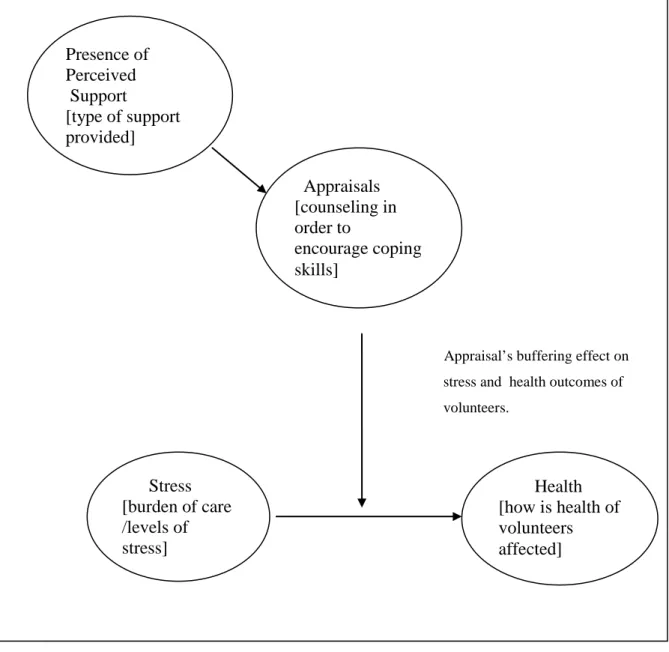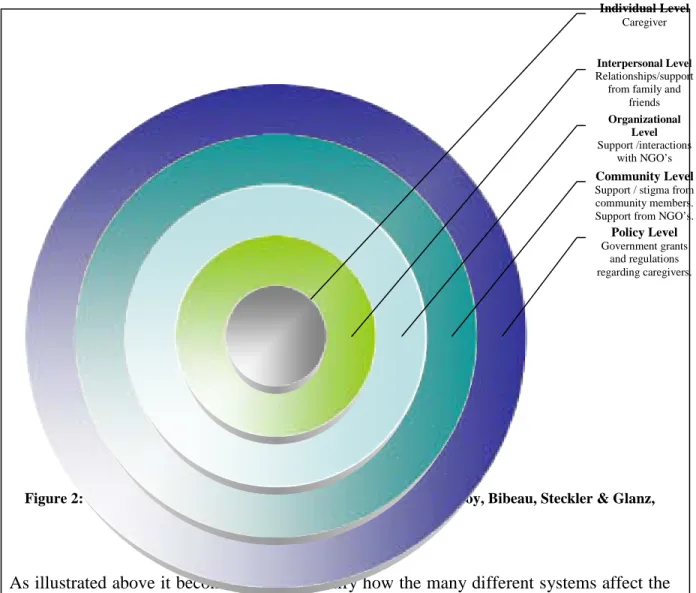Findings from this study indicated that caregiving burden, stigma experienced by volunteer caregivers, relationships between volunteers and community members, and social networks played an important role in the need to provide social support to volunteers. Issues related to social trust and social networks played a key role in accessing social support, ultimately affecting the effectiveness of care provided by volunteers.
Introduction and Background
No documented qualitative study was found that applied aspects of social support theory and the social capital framework that focused exclusively on the social support experiences of volunteer carers in South Africa. D'Cruz's study used social capital theory as the main theoretical framework, while this study uses aspects of social support theory, socio-ecological theory, and elements of the social capital framework.
Problem Statement
6 This study can reveal some of the dynamics of these relationships and shed light on many issues, e.g. For these reasons, this study will provide valuable insight not only into the experiences and availability of social support among volunteer carers, but also into the wider contextual factors in which these experiences occur.
Research Questions
The above quote reflects a lack of tangible and emotional support from the family members of the patient. The above quote indicates a strained relationship between the volunteer and the healthcare workers as a result of receiving the volunteers from the community/patients. Social bonding is urgently needed to improve the relationship between the volunteer and the family of the patient.
The support needs of the volunteers were enormous due to the nature of their caring work.

Structure of the dissertation
Global Perspective of HIV/AIDS
Sub-Saharan Africa
10 In Africa south of the Sahara, HIV/AIDS arose within a context where socio-cultural factors shaped the manifestation and consequences of the disease. In a study conducted by Homan, Searle, Esu-Williams, Aguire, Mafata, Meidany, Osthuizen & Towel (2005), it was found that more than half of the HIV/AIDS affected households were unemployed and a further six percent have no source of income.
South African context
Home-based care is carried out by volunteers working through non-governmental organizations (NGOs) or family caregivers as a viable alternative to hospital care (Akintola, 2008b). However, such home care programs often receive little support from the government (Steinberg et al. 2002), leaving care organizations to rely primarily on volunteers to provide care to people living with HIV/AIDS.
Home-based care within the context of HIV/AIDS
The burden of care
52 Again, it is suggested that the volunteer's personal development is compromised due to the burden of care. It emerged from the data that the following forms of social support were necessary for the volunteer carers in the KwaNgcolosi community.
The impact of caregiving on the health of the caregiver
HIV/AIDS related stigma attached to caregivers
18 Although caregivers play an important role in caring for people with HIV/AIDS, they face discrimination and stigma from community members due to the nature of their care work (Akintola, 2004; Turner, Pearlin & Mullan, 1998). Therefore, it is logical that caregivers may fall victim to this type of stigmatization due to the fact that they are closely related to people living with HIV/AIDS and are greatly affected by the consequences of HIV/AIDS.
Stress and burnout related to caregiving
The study also found that volunteers received more support from organizational staff than their fellow volunteers (Maslanka, 1996). Simpson's (2006) mixed method study focusing on the amount of psychosocial support provided to primary (family), secondary (volunteer) and tertiary (community based) carers discussed burnout as one of the findings.
Social Capital and its Role in the Provision of Social Support…. 24
This study draws on various aspects of social support theory as the main conceptual framework. The study will be based on aspects of social support theory, namely tangible, informational, evaluative and emotional support for the purpose of the study.
Setting and context of the study
Design
Sample
Volunteers participating in the study were purposively selected on the basis that they have worked with PLWHA. A sample of this size provided the researcher with a thick and rich record of the volunteers' experiences.
Data collection and procedure
Interviews were conducted by a translator into isiZulu (in the presence of the researcher) as the participating caregivers spoke isiZulu as their first language and have limited fluency in English, which is the researcher's first language. The researcher remained present during each interview and, if necessary, asked questions through a translator.
Data analysis
This would allow the researcher to extract relevant themes from the data presented. After the coding process is complete, the researcher can further examine the coded themes for major subthemes emerging from the data (Ulin, 2005).
Ethical consideration
Limitations of the study
Introduction
Daily patient care duties
Daily routine
Care work began already at 8.00, where volunteers often had to walk a distance of more than 15 minutes between each patient. This suggests that their care work was physically and perhaps emotionally draining on the care staff, as due to the demands of the care work they would not be able to play the role of mother, wife and home carer.
Finding/accessing Patient
One of the challenges for caregivers as interpreted by the above quotes is the issue of respecting the autonomy of the patient's families. 44 a sick person lived with them, was the volunteer able to take care of the patient.
Patient relationships with their families
Family neglect
The data shows that the volunteers were sometimes contacted late at night by the patient's family members. This finding indicates a serious breakdown of social trust between the patient, the patient's family and the volunteer.
Volunteer’s relationship with patient’s families (role confusion)…. 45
- Gender distinctions in care preference
Inaccessibility of AIDS grants
The lack of support from the government in terms of the provision of the AIDS grant had a ripple effect on that of volunteers. 49 family of the patient when the allowance is made available and then has to return to her once recovered patient who is sick again.
Poverty
Living conditions of the patient
50 When asked if her family and husband knew that she took food from their home to feed her patient, Participant 2 replied;. More significantly, it indicates that the volunteers did not find support from organizations as well as their own homes and therefore had to steal food from their homes.
Burden of care
Consequences of care work on volunteer family life
Dangers of the job
Late-night house visits by volunteers proved dangerous, as volunteers had to walk long distances, alone and in the dark, to patients' homes. 53 and the urgent need for material support (transportation) and emotional support in the form of counseling on occupational stress.
Support provided
- Support provided by the co-ordinator
- Support provided by the volunteer’s family
- Volunteer’s support eachother
- Support provided from the community health care clinic
As a result of the strained relationship between volunteer and healthcare worker, tangible support in the form of work materials was provided, but the support was provided only on certain conditions. The above findings indicate a relative provision of social support to the volunteer, but also highlight a breakdown in the crucial relationship between the volunteer and healthcare worker.
Unmet support needs
Social support needed
- Hospice
- Training
- Food
- Transport
- Money
- From researchers
- Government
- Community
- Community stigma/ridicule
- Volunteer’s family
- Religious groups
- Social cohesion/social solidarity
- Insufficient funds
- Dignified burial of the patient
- AIDS orphans
The findings revealed that, according to the volunteers, community members were very unsupportive of the care work being done. The findings cited regarding the lack of support from community members indicate a negative perception of community members.
Introduction
The burden of care
These bonds of trust may have somewhat reduced the burden faced by volunteers. 77 somewhat confused by the role of the volunteer and treated the volunteers as if they had to divide their duties between the patient and the housework.
The stigma of AIDS
These findings suggest a lack of tangible support from the patient's family members and also imply that the patient's family members displayed ignorance of the volunteers' duties. In light of the stigma experienced by volunteers, there is a need to bridge the relationship between volunteers and the community in the form of educating community members about HIV/AIDS, as well as the nature of the volunteer's care work.
Patient neglect
However, I have not found any literature that discusses the family of the patient's abuse of the AIDS grant. By doing so, the family members can adopt and appreciate the AIDS grant to improve the patient's quality of life and in turn will not make the volunteer feel taken advantage of.
Poverty
Family members should accept their role as the primary caregivers of the patient by accepting basic training from the volunteer as suggested by the literature (Akintola, 2008b). The social connection between the families and the patient is necessary due to the fact that the family members were emotionally disconnected from the patient.
Social support provided
This strengthened the bonds of trust between the two, but put enormous pressure on the volunteer. An interesting relationship of support provided was that between the volunteer and the healthcare workers.
Social support needed
The behavior of health workers may be due to resentment of the close relationship between the volunteer and the patient as opposed to the strained relationship between the patient and the health worker. 88 organizations, volunteers and organizations must come together in an open forum to discuss the needs of volunteers.
Recommendations
Stakeholders
- Tangible
- Appraisal and emotional support
- Social networks and trust
It is recommended that regular patient care workshops are held for volunteers, conducted and led by nurses from surrounding clinics. Mediation should be facilitated between the above mentioned parties to bridge the gap between them.
Areas for further research
Hitting Home: How households cope with the impact of the HIV/AIDS epidemic: A survey of households affected by HIV/AIDS in South Africa. NGOs, churches etc. can offer support in the form of an aftercare facility for the children of the volunteer where a meal is also provided.
